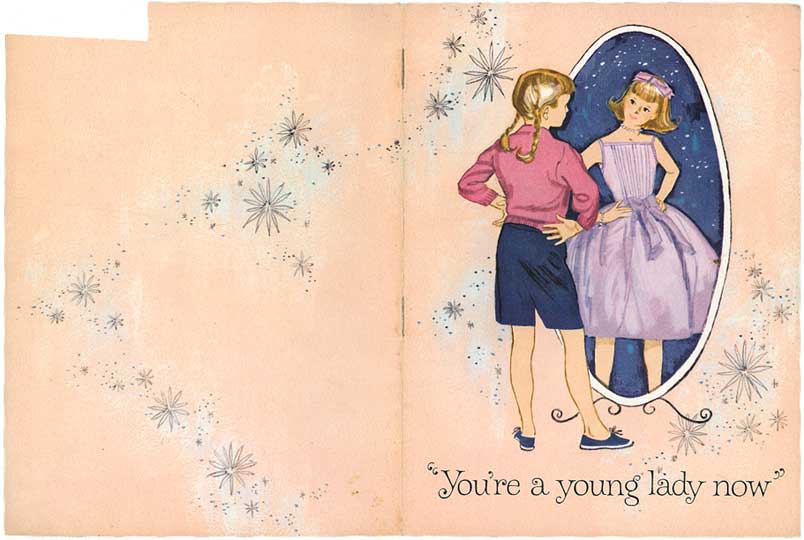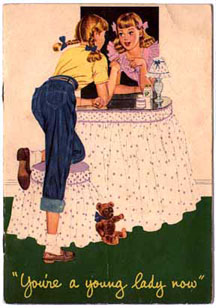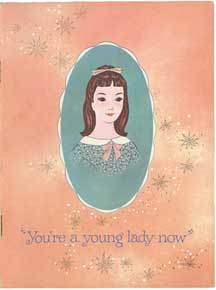See a Kotex ad
advertising this booklet.
Read a Personal Products booklet for older
girls from about this time, The Periodic Cycle
(1938). See similar
booklets on this site.
See a Kotex ad
advertising a Marjorie May booklet.
See many more similar booklets.
See ads for
menarche-education booklets: Marjorie May's Twelfth
Birthday (Kotex, 1932), Tampax tampons (1970,
with Susan Dey), Personal
Products (1955, with Carol Lynley),
and German o.b.
tampons (lower ad, 1981)
And read Lynn Peril's series about
these and similar booklets!
Read the full text of the 1935 Canadian edition
of Marjorie May's Twelfth Birthday, probably
identical to the American edition.
More ads for teens (see also introductory page
for teenage advertising): Are you in the know? (Kotex napkins and Quest
napkin powder, 1948, U.S.A.), Are you in the know? (Kotex napkins and belts,
1949, U.S.A.)Are
you in the know?
(Kotex napkins, 1953, U.S.A.), Are you in the know? (Kotex napkins and belts,
1964, U.S.A.), Freedom (1990, Germany), Kotex (1992, U.S.A.), Pursettes (1974, U.S.A.), Pursettes (1974, U.S.A.), Saba (1975, Denmark)
See early tampons
and a list of tampon
on this site - at least the ones I've
cataloged.


|

"You're a young lady now" (Kotex puberty
& menstruation booklet,
U.S.A., 1959)
Complete booklet
This
booklet for menarcheal girls,
which experienced at least 3
editions (see the 1952 and 1961
versions), continued the unstuffy language
possibly begun by the Kotex
booklet As One Girl to
Another,
(1940), a great departure from
Kotex's Marjorie
May's Twelfth Birthday booklets of the
1920s-1930s. About this time,
Kotex went overboard, but
pleasingly so, immersing its ads
in slang in the "Are You in
the Know?" series. Read more about these
booklets; here are the ones on
this site.
This
version is longer than the 1952 one and the
drawings and layout are
different. Parts of the text are
different. It's almost identical
to the 1961 edition.
Even
though prepubescent girls wore
dresses, here a dress
represented puberty. But older
girls also wore pants at the
time. Did she wear a dress for
the boys? Compare the two
covers, below.
(See a Modess booklet from
the same year.)
Look at the upper left corner of
the back page; someone cut it. Could the
owner's name have been there?
That's the exact spot the owner of
the earlier edition wrote her
name (see below). I
wonder if teachers told students
to write their names in the same
place - 7 years apart! Maybe
learning that spot is required for
teacher certification.
|
 |
Below:
The covers of the booklet
reproduced in the next
several pages.
Left:
The top of the back cover
of the previous edition (1952)
shows how the name of the
owner (I think) fits in
the same spot as the
missing chunk in the
edition below, where
probably its (shy?) owner
put her name.
|
|
Each page measures 5 x
6.75" (12.6 x 17 cm).
|
 |
Below:
The covers of the 1952
edition, maybe by the same
artist, and 1961
version. Again, it shows
pants on the prepubescent
girl and a dress on the
menarcheal one. The 1961
cover dispenses with
showing change but
continues the
feminine-appearance theme.
1952
|
1961
|
 |
 |
|
|
|
© 2007 Harry Finley. It is
illegal to reproduce or distribute
any of the work on this Web site
in any manner or medium without
written permission of the author.
Please report suspected violations
to hfinley@mum.org
|
|
|